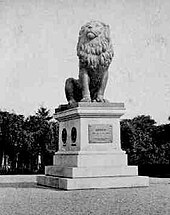Isted Lion
| Isted Lion | |
|---|---|
Istedløven | |
| Danish Palace and Properties Agency Danish: Slots- og Ejendomsstyrelsen | |
 | |
| For victory in the Battle of Isted | |
| Unveiled | 25 July 1862 in Flensburg |
| Location | |
| Designed by | Herman Wilhelm Bissen |
ISTED DEN 25. JULI 1850 REJST 1862 2011 wieder errichtet als Zeichen von Freundschaft und Vertrauen zwischen Dänen und Deutschen | |
The Isted Lion (or Flensburg Lion) (Danish: Istedløven or Flensborgløven; German: Flensburger Löwe or Idstedter Löwe) is a Danish war monument originally intended as a monument of the Danish victory over German-minded Schleswig-Holstein insurgents in the Battle of Isted (Idstedt) on 25 July 1850, during the First Schleswig War which was a civil war within the Danish Realm, although with troops from Prussia supporting the Schleswig-Holstein insurgents. At its time it was the largest battle in Scandinavian history.
Others perceived it more as a memorial for the Danish dead in the battle.[1]
Originally erected in
History
Flensburg

Following the Danish victory over
The lion is derived from the
Isted den 25. Juli 1850. Det danske Folk reiste dette Minde
(Isted, 25 July 1850. The Danish people set this memorial)
The statue was unveiled on the 12th anniversary of the battle, 25 July 1862, at St Mary's Cemetery in
Erecting the monument in Flensburg rather than Copenhagen or Isted, was seen as a provocation by the region's German nationalists who opposed the Danish claim to sovereignty over the area. The decision to let the lion face south reinforced this feeling. Flensburg was divided by national sympathies but had a pro-Danish majority until after the 1864 war.
Berlin

In 1864,
Following the occupation of Flensburg by German forces, German nationalists attacked the monument and tried to topple it. They succeeded in removing the tail and part of the lion's back but failed to destroy the statue due to the intervention of German authorities.
The Prime Minister of Prussia, Otto von Bismarck, ordered the monument to be dismantled, and its parts were originally stored in the courtyard of the Schleswig Estates in Flensburg. In 1867, the lion and the four reliefs were moved to Berlin at the order of Generalfeldmarschall Friedrich Graf von Wrangel.
The reassembled lion was erected in the
In 1874, a
Copenhagen
Following the defeat of
In the autumn of 1945, the paperwork had been completed, and an American army convoy headed for Copenhagen, where it arrived on October 5. On October 20, the lion was officially handed over to King
From 1945 to 1947, a few Danish politicians, with wide support in the popular opinion, advocated for a re-annexation of Southern Schleswig, and in particular Flensburg – resulting in a fierce political debate. As the debate ended with a confirmation of the existing border, the same politicians ruled out the possibility of returning the statue to a German-ruled town. On a number of occasions, controversy over the monument resurfaced, as a new generation of politicians began advocating for its return to a German-administered Flensburg.
In 1999, construction of a new
A committee in Fredericia, already the home of Bissen's other main work, the statue of the Foot Soldier, was lobbying for moving the monument there.[5]

Return to Flensburg
At the request of the city council of Flensburg, the Danish Government decided to return the Isted Lion to its original home in Flensburg. On 10 September 2011, it returned to the military cemetery, where it was first erected. The ceremony was attended by HRH Prince Joachim of Denmark.
References
- ^ a b Kragelund, Britta (February 2002). "Istedløven". Dansk-Skånsk Tidsskrift no. 1, 2002 (in Danish). Archived from the original on 2007-03-10. Retrieved 2006-07-14.
- ^ Jensen, Hans Jørgen. "Herman Wilhelm Bissen" (in Danish). Kulturcenteret Assistens. Archived from the original on 2006-06-15. Retrieved 2006-07-14.
- ^ a b c Laursen, Gert. "Istedløven". Dansk militærhistorie (in Danish). Archived from the original on 2006-06-20. Retrieved 2006-07-14.
- ^ a b "Der Flensburger Löwe" (in German). Haus der Wannsee-Konferenz. Gedenk- und Bildungsstätte. 2005-06-07. Archived from the original on 2006-01-14. Retrieved 2006-07-14.
- ^ a b Christlieb, Emanuel; Christiansen, Thomas Kvist. "Istedløven blev født i Fredericia" (in Danish). Foreningen Til Istedløvens Placering i Fredericia. Retrieved 2006-07-14.
- ^ a b Kurtz, Michael J. (2006). America and the return of Nazi contraband. Cambridge University Press. p. 134.
- ^ Eduard Troelsgård. Rådgivende ingeniører. "Istedløven" (in Danish). Archived from the original on 2007-06-13. Retrieved 2006-07-14.
- ^ Official website of the Danish Parliament. "1998-99. Svar på § 20-spørgsmål: Placeringen af Istedløven" (in Danish). Retrieved 2006-07-14.
- Part of the information regarding the copy in Berlin is based on the corresponding article on the German Wikipedia, accessed on 12 June 2006.
- Den Store Danske Encyklopædi, CD-ROM edition, entry Istedløven (in Danish)
External links
![]() Media related to Isted Lion at Wikimedia Commons
Media related to Isted Lion at Wikimedia Commons
- Official museum website about the monument (in Danish)
- Website advocating for the movement of the lion to Fredericia (in Danish)
- Flensburg Online Magazine about the monument (in German)
- Official website of Berlin mentioning the monument (in German)


